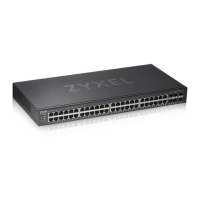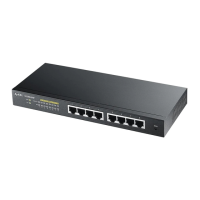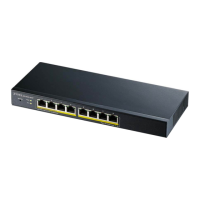Chapter 43 Queuing Method
GS1920v2 Series User’s Guide
261
CHAPTER 43
Queuing Method
43.1 Queuing Method Overview
This section introduces the queuing methods supported.
Queuing is used to help solve performance degradation when there is network congestion. Use the
Queuing Method screen to configure queuing algorithms for outgoing traffic. See also Priority Queue
Assignment in the SWITCHING > QoS > Priority Queue screen and 802.1p Priority in the PORT > Port Setup
screen for related information.
43.1.1 What You Can Do
Use the Queuing Method screen (Section 43.2 on page 262) to set priorities for the queues of the Switch.
This distributes bandwidth across the different traffic queues.
43.1.2 What You Need to Know
Queuing algorithms allow switches to maintain separate queues for packets from each individual
source or flow and prevent a source from monopolizing the bandwidth.
Strictly Priority Queuing
Strictly Priority Queuing (SPQ) services queues based on priority only. As traffic comes into the Switch,
traffic on the highest priority queue, Q7 is transmitted first. When that queue empties, traffic on the next
highest-priority queue, Q6 is transmitted until Q6 empties, and then traffic is transmitted on Q5 and so on.
If higher priority queues never empty, then traffic on lower priority queues never gets sent. SPQ does not
automatically adapt to changing network requirements.
Weighted Fair Queuing
Weighted Fair Queuing is used to guarantee each queue's minimum bandwidth based on its bandwidth
weight (portion) (the number you configure in the Weight field) when there is traffic congestion. WFQ is
activated only when a port has more traffic than it can handle. Queues with larger weights get more
guaranteed bandwidth than queues with smaller weights. This queuing mechanism is highly efficient in
that it divides any available bandwidth across the different traffic queues. By default, the weight for Q0
is 1, for Q1 is 2, for Q2 is 3, and so on.
Weighted Round Robin Scheduling (WRR)
Round Robin Scheduling services queues on a rotating basis and is activated only when a port has more
traffic than it can handle. A queue is given an amount of bandwidth irrespective of the incoming traffic

